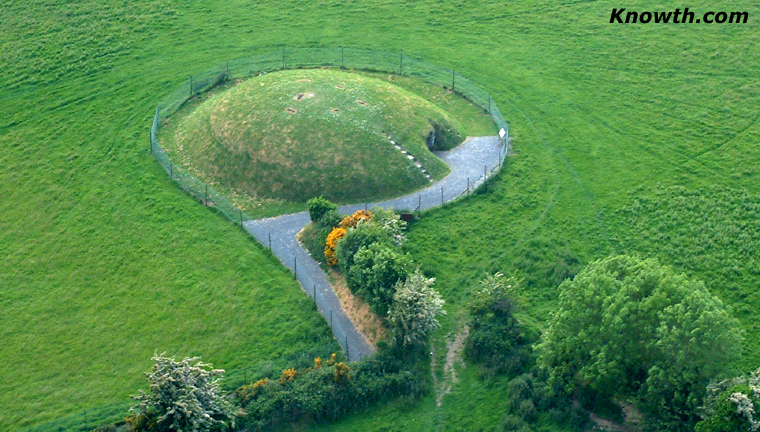
We Have Never Been Material.
Andrew Cochrane 2007 - Page 5SO HOW WERE THINGS? (Continued)
The absence of basins in other passage tombs is equally as interesting as their presence. The eastern tomb at Knockroe does not contain a basin, but does have a bowl-shaped pit in the floor of the end/terminal chamber that either could have incorporated a basin that was later removed (O'Sullivan 1995, 21), or alternatively was dug to simulate some of the actions of a basin. For instance, cremated remains may have been placed in the pit to facilitate a journey, or liquids may have been pored into the pit to assist in activation of the chamber itself. The lack of basins in the majority of Irish passage tombs suggests that their inclusion was particular to the location and requirements of specific sites, rather than as part of an island-wide passage tomb ‘blue-print'.The stone objects in passage tombs may have embodied other places and other times, radiating some of their essences through presence or by appropriating their influences. The placement of these parts into a passage tomb with cremated remains may have served to further project them into the cosmos or alternative relationships (Fowler 2004, 140). Certainly, the process of cremation may have facilitated the release of some elements to the heavens. Such engagements may have been viewed by some as acts of renewal and regeneration, especially if associated with engraved imagery and connections with other realms (physical or otherwise). The placement of material objects in passage tombs upon the floors and in the chambers would have created temporal sequential layers, with early deposits being recognisable.
These acts would have generated a textured and sublime bricolage (Thomas 1990, 175; 1999, 79), a ‘cosmoscape' of variant parts: stone, earth, clay, bone, pottery, chalk, antler, ash, charcoal, and plant matter. The notion of mixed and textured layering is enhanced when one also includes the sequential application of motifs upon the stones. Each of these elements would continually be (re)understood, reformed and re-aligned through use and fluid change (Shanks 1992, 190). Such performances would render the passage tombs locations as ‘technologies of disclosure' (Brittain, 2006) and revelation within spheres of activity that often overlap (Thomas 1996, 178). As such, the repetition of resembling artefacts in Irish passage tombs is more than the marking of similarities; it is also the growth and magnification of differences via quantities and placements.
The sensory qualities of particular substances seem to have played a role in determining what materials were employed. For example, the colour of stone seems to have been important in choosing what went where. In the Boyne Valley complex and Knockroe, the soft green coloured greywacke was the preferred (although not exclusive) medium for imagery carved on structural stones (O'Sullivan 1997, 28). The placement of a pink sandstone orthostat in the western tomb, Knockroe; white quartz facades, platforms and standing stones in the Boyne Valley and Loughcrew complexes; and blue carboniferous limestone for the uprights and roof corbels at Fourknocks I all suggest deliberate combination and juxtaposition of substances of differing form, colour, texture and composition. Indeed, the colours of particular stones may have operated in similar ways as the imagery present (O'Sullivan 1997, 30).
The coloured stones may have performed as agents of external manipulation, forming and moulding social ideals, through a complex web of relations. Latour's (2000) example of the Berlin Key demonstrates a similar type of engagement with material objects. This unique key is designed so that when a person unlocks the door to a property, they are forced to lock the door behind them in order to gain entry. In such an interaction, it is the key that determines the required social action of maintaining security obligations, and not the resident. In a different context, barbed wire can also determine or instigate movement and action. The structural stones, especially those of differing colours and textures, with or without motifs, may equally have created social interconnections within active and sensuous networks.
Next Page (6)
Previous Page (4)
Boyne Valley Private Day Tour
 Immerse yourself in the rich heritage and culture of the Boyne Valley with our full-day private tours.
Visit Newgrange World Heritage site, explore the Hill of Slane, where Saint Patrick famously lit the Paschal fire.
Discover the Hill of Tara, the ancient seat of power for the High Kings of Ireland.
Book Now
Immerse yourself in the rich heritage and culture of the Boyne Valley with our full-day private tours.
Visit Newgrange World Heritage site, explore the Hill of Slane, where Saint Patrick famously lit the Paschal fire.
Discover the Hill of Tara, the ancient seat of power for the High Kings of Ireland.
Book Now
Home
| Newgrange
| Knowth
| Dowth
| Hill of Tara
| Fourknocks
| Loughcrew
| More Places
| Labyrinths
| Local Info
| Art Works
| Articles
| Images
| Books
| Links
| Boyne Valley Tours
| Contact
